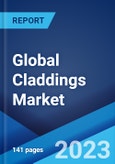The global claddings market size reached US$ 243.5 Billion in 2022. Looking forward, the market is expected to reach US$ 347.8 Billion by 2028, exhibiting a growth rate (CAGR) of 6.12% during 2022-2028.
Cladding is a non-loadbearing construction material attached to the exterior and interior of the building to act as a moisture barrier and protective layer. It is usually manufactured using wood, natural stone, metal, aluminum, zinc, copper, plastic, terracotta, vinyl and other composite materials. Cladding is lightweight, fireproof, thermal- and water-resistant, soundproof and energy-efficient. It is also added to the floors, walls, facades, plateaus, baseboards and planters to enhance their aesthetic appeal and is directly attached to the steel frame of the building. Novel cladding materials are manufactured with dichromatic window films to provide ultraviolet (UV) protection to the interiors of the building and minimize maintenance requirements.
Cladding is a non-loadbearing construction material attached to the exterior and interior of the building to act as a moisture barrier and protective layer. It is usually manufactured using wood, natural stone, metal, aluminum, zinc, copper, plastic, terracotta, vinyl and other composite materials. Cladding is lightweight, fireproof, thermal- and water-resistant, soundproof and energy-efficient. It is also added to the floors, walls, facades, plateaus, baseboards and planters to enhance their aesthetic appeal and is directly attached to the steel frame of the building. Novel cladding materials are manufactured with dichromatic window films to provide ultraviolet (UV) protection to the interiors of the building and minimize maintenance requirements.
Claddings Market Trends
Significant growth in the construction industry across the globe is one of the key factors creating a positive outlook for the market. Moreover, the increasing requirement of metallic claddings in commercial and industrial buildings is providing a thrust to the market growth. Claddings are widely used as effective protective systems in residential and non-residential constructions against exposure to harsh climatic conditions, dust, pollution and changes in temperatures. In line with this, the widespread adoption of claddings for the protection of vertical and roof-top gardens is also contributing to the growth of the market. Additionally, the increasing utilization of fiber cement in cladding systems is acting as another growth-inducing factor. Product manufacturers are also developing bio-based and sustainable cladding materials using agricultural and paper waste, which are widely utilized in green buildings. Other factors, including rising expenditure capacities of the consumers and the implementation of favorable government policies, along with extensive infrastructural development, especially in the developing economies, are anticipated to drive the market toward growth.Key Market Segmentation
This research provides an analysis of the key trends in each sub-segment of the global claddings market report, along with forecasts at the global, regional and country level from 2023-2028. The report has categorized the market based on material type, component type and end user.Breakup by Material Type:
- Masonry and Concrete
- Brick and Stone
- Stucco and EIFS
- Fiber Cement
- Metal
- Vinyl
- Wood
Breakup by Component Type:
- Walls
- Roof Cladding
- Windows and Doors
Breakup by End User:
- Residential
- Non-Residential
Breakup by Region:
- North America
- United States
- Canada
- Asia-Pacific
- China
- Japan
- India
- South Korea
- Australia
- Indonesia
- Europe
- Germany
- France
- United Kingdom
- Italy
- Spain
- Russia
- Latin America
- Brazil
- Mexico
- Middle East and Africa
Competitive Landscape
The competitive landscape of the industry has also been examined along with the profiles of the key players being Acme Brick (Berkshire Hathaway Inc.), Alcoa Corporation, Armstrong World Industries, Boral, CSR Limited, Etex Group, James Hardie Building Products Inc, Kingspan Group, NICHIHA Co. Ltd, ROCKWOOL International A/S, Tata BlueScope Steel, Trespa International B.V and Westlake Chemical Corporation.Key Questions Answered in This Report:
- How has the global claddings market performed so far and how will it perform in the coming years?
- What has been the impact of COVID-19 on the global claddings market?
- What are the key regional markets?
- What is the breakup of the market based on the material type?
- What is the breakup of the market based on the component type?
- What is the breakup of the market based on the end user?
- What are the various stages in the value chain of the industry?
- What are the key driving factors and challenges in the industry?
- What is the structure of the global claddings market and who are the key players?
- What is the degree of competition in the industry?
Table of Contents
1 Preface3 Executive Summary11 Value Chain Analysis13 Price Analysis
2 Scope and Methodology
4 Introduction
5 Global Claddings Market
6 Market Breakup by Material Type
7 Market Breakup by Component Type
8 Market Breakup by End User
9 Market Breakup by Region
10 SWOT Analysis
12 Porters Five Forces Analysis
14 Competitive Landscape
Companies Mentioned
- Acme Brick (Berkshire Hathaway Inc.)
- Alcoa Corporation
- Armstrong World Industries
- Boral
- CSR Limited
- Etex Group
- James Hardie Building Products Inc
- Kingspan Group
- NICHIHA Co. Ltd
- ROCKWOOL International A/S
- Tata BlueScope Steel
- Trespa International B.V
- Westlake Chemical Corporation
Methodology

LOADING...
Table Information
| Report Attribute | Details |
|---|---|
| No. of Pages | 141 |
| Published | November 2023 |
| Forecast Period | 2022 - 2028 |
| Estimated Market Value ( USD | $ 243.5 Billion |
| Forecasted Market Value ( USD | $ 347.8 Billion |
| Compound Annual Growth Rate | 6.1% |
| Regions Covered | Global |
| No. of Companies Mentioned | 13 |









